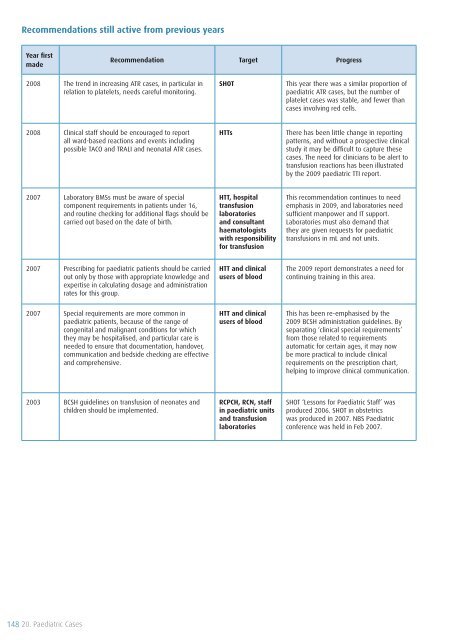SHOT Annual Report 2009 - Serious Hazards of Transfusion
SHOT Annual Report 2009 - Serious Hazards of Transfusion
SHOT Annual Report 2009 - Serious Hazards of Transfusion
You also want an ePaper? Increase the reach of your titles
YUMPU automatically turns print PDFs into web optimized ePapers that Google loves.
Recommendations still active from previous years<br />
Year first<br />
made<br />
Recommendation Target Progress<br />
2008 The trend in increasing ATR cases, in particular in<br />
relation to platelets, needs careful monitoring.<br />
<strong>SHOT</strong><br />
This year there was a similar proportion <strong>of</strong><br />
paediatric ATR cases, but the number <strong>of</strong><br />
platelet cases was stable, and fewer than<br />
cases involving red cells.<br />
2008 Clinical staff should be encouraged to report<br />
all ward-based reactions and events including<br />
possible TACO and TRALI and neonatal ATR cases.<br />
HTTs<br />
There has been little change in reporting<br />
patterns, and without a prospective clinical<br />
study it may be difficult to capture these<br />
cases. The need for clinicians to be alert to<br />
transfusion reactions has been illustrated<br />
by the <strong>2009</strong> paediatric TTI report.<br />
2007 Laboratory BMSs must be aware <strong>of</strong> special<br />
component requirements in patients under 16,<br />
and routine checking for additional flags should be<br />
carried out based on the date <strong>of</strong> birth.<br />
HTT, hospital<br />
transfusion<br />
laboratories<br />
and consultant<br />
haematologists<br />
with responsibility<br />
for transfusion<br />
This recommendation continues to need<br />
emphasis in <strong>2009</strong>, and laboratories need<br />
sufficient manpower and IT support.<br />
Laboratories must also demand that<br />
they are given requests for paediatric<br />
transfusions in mL and not units.<br />
2007 Prescribing for paediatric patients should be carried<br />
out only by those with appropriate knowledge and<br />
expertise in calculating dosage and administration<br />
rates for this group.<br />
HTT and clinical<br />
users <strong>of</strong> blood<br />
The <strong>2009</strong> report demonstrates a need for<br />
continuing training in this area.<br />
2007 Special requirements are more common in<br />
paediatric patients, because <strong>of</strong> the range <strong>of</strong><br />
congenital and malignant conditions for which<br />
they may be hospitalised, and particular care is<br />
needed to ensure that documentation, handover,<br />
communication and bedside checking are effective<br />
and comprehensive.<br />
HTT and clinical<br />
users <strong>of</strong> blood<br />
This has been re-emphasised by the<br />
<strong>2009</strong> BCSH administration guidelines. By<br />
separating ‘clinical special requirements’<br />
from those related to requirements<br />
automatic for certain ages, it may now<br />
be more practical to include clinical<br />
requirements on the prescription chart,<br />
helping to improve clinical communication.<br />
2003 BCSH guidelines on transfusion <strong>of</strong> neonates and<br />
children should be implemented.<br />
RCPCH, RCN, staff<br />
in paediatric units<br />
and transfusion<br />
laboratories<br />
<strong>SHOT</strong> ‘Lessons for Paediatric Staff’ was<br />
produced 2006. <strong>SHOT</strong> in obstetrics<br />
was produced in 2007. NBS Paediatric<br />
conference was held in Feb 2007.<br />
148 20. Paediatric Cases












